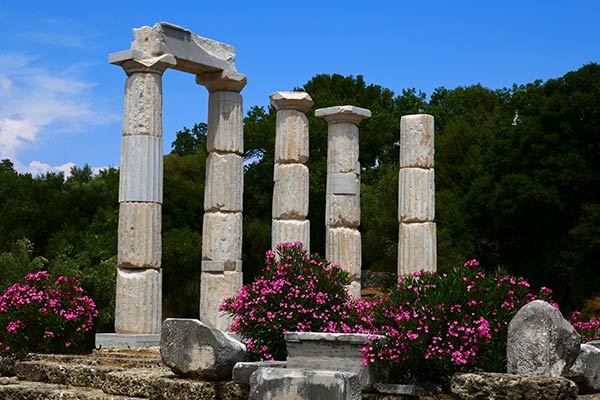
Sanctuary of the Great Gods (Enlarge)
Samothrace (also spelled as Samothraki) is a mountainous Greek island in the remote northern Aegean Sea. Eleven miles (17 kilometers) long and 69 square miles in size (178 square kilometers) it is best known for its central peak of Mt. Fengari (5285 feet, 1611 meters), an ancient temple called the Sanctuary of the Great Gods, and the famous state of the Goddess Nike. Similar to the oracle sites of Delphi and Dodona in mainland Greece, the Sanctuary of the Great Gods was the location of a mystery school that attracted worshippers from the entire Greek and Roman world for more than a thousand years. The identity and nature of the gods worshipped at Samothrace, however, remains somewhat enigmatic.

Samothrace Island (Enlarge)
Ancient writers refer to them with the name of Kabeiroi, while in the epigraphic record they are simply called Gods or Great Gods. Their secret names were Axieros, Axiokersa, Axiokersos and Kadmilos, whom the Greeks identified, as early as the middle of the 4th century BC, with Demeter, Persephone, Hades and Hermes. Axieros was the central figure of a cult of the Great Mother, with characteristics similar to those of the Phrygian goddess Kybele, the Anatolian Great Mother, and the Trojan Mother Goddess of Mount Ida. The Greeks associated her equally with the fertility goddess Demeter. The Great Mother is the all-powerful mistress of the wild world of the mountains, venerated on sacred rocks where sacrifices and offerings were made to her. The Great Mother was often depicted on Samothracian coinage as a seated woman, with a lion at her side. Hecate, under the name of Zerynthia, and Aphrodite-Zerynthia, two other important nature goddesses, are equally venerated at Samothrace.
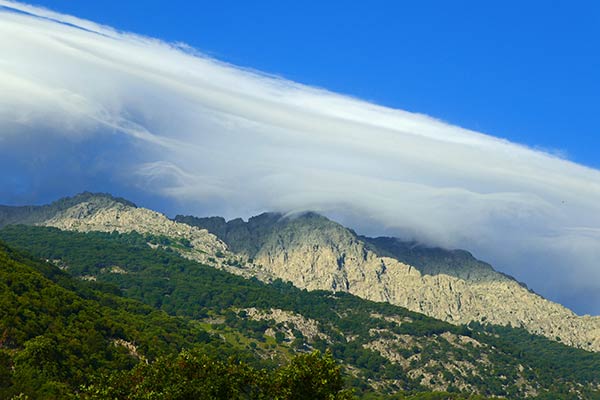
Mt. Fengari (Enlarge)
The sanctuary of the Great Gods was open to all who wished to worship, although access to those buildings consecrated to the mysteries was reserved for initiates. The rituals and ceremonies of the mysteries were presided over by a priestess, and often a prophetess called a Sybil, or Cybele. The most common rituals were probably similar to those at other Greek sanctuaries: prayer and supplications accompanied by sacrifices of domestic animals (sheep and pigs), as well as libations made to the chthonic earth deities in circular or rectangular stone pits. The initiate cherished the hope of good fortune, protection from the dangers of sea voyages and the promise of a happy afterlife.
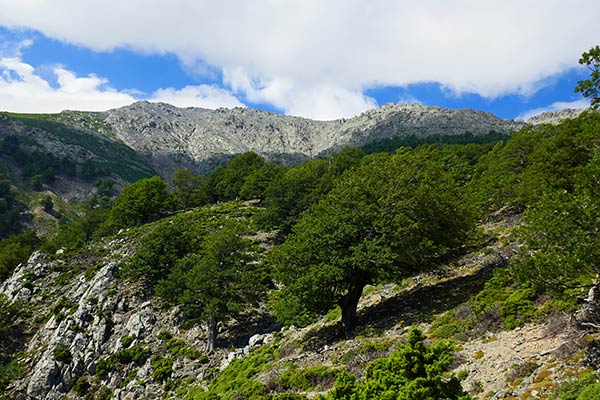
Mt. Fengari (Enlarge)
The major annual festival, which drew pilgrims to the island from throughout the Greek world, probably took place in mid-July. It consisted of the presentation of a sacred play, which entailed a ritual wedding of Cadmos and Harmonia.
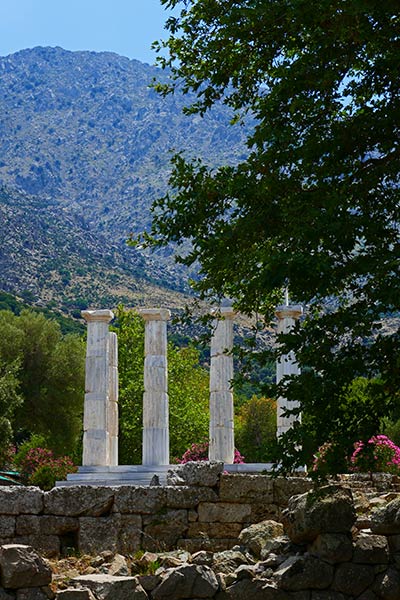
Sanctuary of the Great Gods (Enlarge)
Archaeological excavations have revealed a picture of the Sanctuary and its development. There is evidence for cult activity since the 7th century BC, although the construction of monumental buildings began only in the 4th and was connected with the magnificence of the royal house of Macedon. It is reported that Phillip II first met Olympias, a princess from Epirus, later his wife and mother of Alexander the Great, on the occasion of their initiation at Samothrace. Alexander's successors continued the royal patronage of the Sanctuary, which attained its greatest splendor in the 3rd and 2nd centuries BC. The cult of the Great Gods and the initiation into their mysteries ceased in the late 4th century AD. It remained an important religious site throughout the Roman period before fading from history towards the end of Late Antiquity.
The most important artifact from the excavations was an eleven-foot tall statue of the winged goddess Nike found by the amateur French archaeologist Charles Champoiseau in 1863. Headless and armless, and currently displayed in the Louvre Museum in Paris, France, this masterpiece of Hellenistic sculpture gave its image to the Rolls Royce emblem and its name to the world's largest athletic shoe manufacturer.
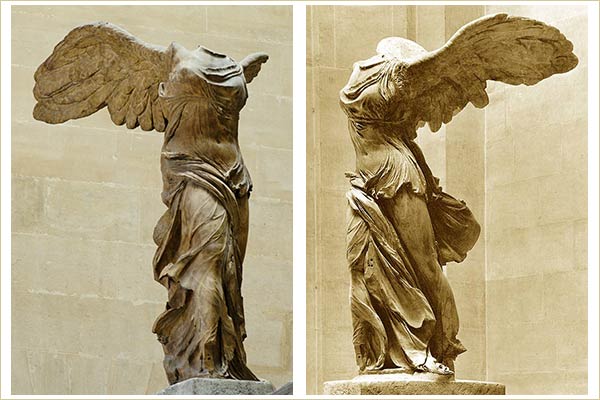
Winged Nike of Samothrace
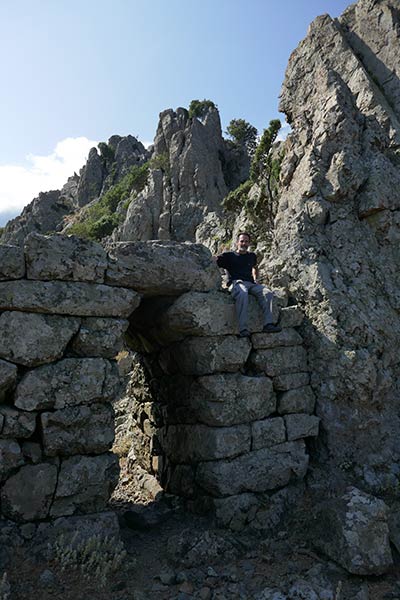
Ruins of Palaeopoli, above the ruins of the Sanctuary of the Great Gods (Enlarge)
Chapel of Panagia Krimniotissa, Samothrace
Perched on a cliff 1020 feet (311 meters) above the beach of Pachia Ammos in southern Samothrace is the small chapel of the Holy Mary called Panagia Krimniotissa. According to legend, Christians fleeing persecution in Asia Minor during the Byzantine Iconoclastic period (730-843 AD) had thrown an icon of the Holy Mary in the Mediterranean Sea. This icon later washed ashore on the beach of Pachia Ammos where it was found by sailors. Placed in a cave (some sources say a beach-side chapel) to protect it, the icon disappeared and miraculously reappeared on a rock at the edge of the cliff high above the beach. Returned to the cave (or the beach-side chapel), each time the icon would disappear and then reappear on the cliff. Believing this to be a divine message, villagers built a new home for the icon on the cliff (Krimnos means cliff) where it is still venerated by pilgrims to this day. The chapel is likened to an eagle’s nest, due to the way it stands along on the rocks.
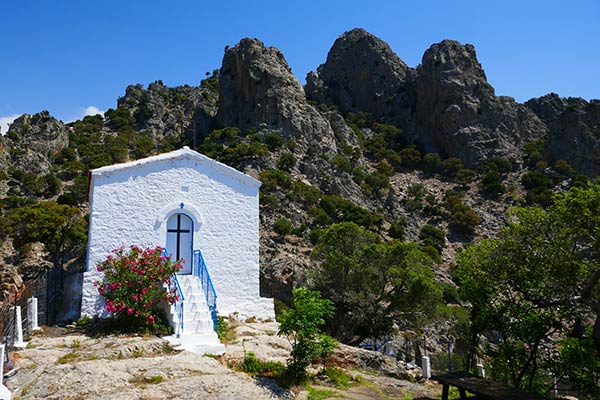
Chapel of Panagia Krimniotissa, Koitada (Enlarge)
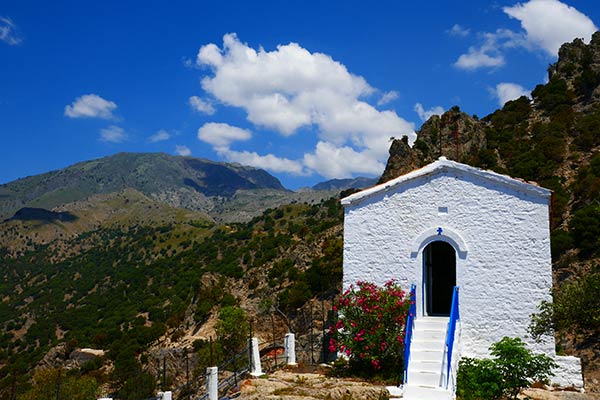
Chapel of Panagia Krimniotissa, Koitada (Enlarge)
Chapel of Panagia Krimniotissa Icon, Koitada (Enlarge)
 Martin Gray is a cultural anthropologist, writer and photographer specializing in the study of pilgrimage traditions and sacred sites around the world. During a 40 year period he has visited more than 2000 pilgrimage places in 165 countries. The World Pilgrimage Guide at sacredsites.com is the most comprehensive source of information on this subject.
Martin Gray is a cultural anthropologist, writer and photographer specializing in the study of pilgrimage traditions and sacred sites around the world. During a 40 year period he has visited more than 2000 pilgrimage places in 165 countries. The World Pilgrimage Guide at sacredsites.com is the most comprehensive source of information on this subject.The preceding information was adapted from the following (and other) sources:
https://en.m.wikipedia.org/wiki/Samothrace_temple_complex
https://greece.terrabook.com/samothrace/page/nike-of-samothrace
http://hellenicperiod.blogspot.com/2012/11/samothrace-temple.html
http://www.theoi.com/Phrygios/Kybele.html
